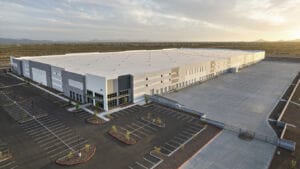Even after designing 150 churches, the team at CCBG Architects takes time to understand the individuality of each project.
For seven months, CCBG President Brian Cassidy met with an East Valley church to learn about its program, mission and teachings. He spent the meetings listening, asking questions and learning about the religious texts before he even put a pen to paper.
CCBG has designed about 150 churches in eight states over the last three decades. Among the work are countless Christian and Catholic churches, a Sikh temple, a Jewish temple, and, most recently, a Mormon temple.
Each campus design comes with its own nuances and intricacies, all of which are discussed in the meetings beforehand. Discussions cover everyday topics like parking considerations to specifics like baptismal font placement, decisions that depend on the individual church, leader and practices at the time.
But baptismal font placement is only one of hundreds of decisions. Following tradition, some churches choose to place the font at the church’s entrance as a symbol of entering the church through the waters. Other churches prefer baptism to be part of the service, and, to avoid craning necks, place it at the front of the church.
“Like anyone else, you just have to learn the people, learn what’s important and come to respect them for what they view the world to be,” says Martin Ball, associate at CCBG.
Before construction, most churches create committees representing various interests within the church — many of whom have little or no background in design, construction or real estate. They advise the architects on their faith, and the architects do their best to work their beliefs into a structure.
Eventually, goals and plans are presented to congregations for approval, starting what often becomes a back and forth conversation about details.
ARTICULATE ARCHITECTURE

Designed by CCBG, The Phoenix Temple of The Church of Jesus Christ of Latter-day Saints opened in late 2014. As the most articulated religious structure CCBG designed, it went through many rounds of discussions and decisions to meet the temple requirements of the LDS church.
While respecting the privacy of the church, the architects still needed to learn about its practices, the other buildings and the teachings. With two temples under construction in Arizona during the design process, the architects were able to get a glimpse and sense of the aesthetic end goal.
Theaters are also in CCBG’s body of work, ushering them into designing a new kind of worship space. Learning the technology of a movie theater allowed the group to expand into contemporary churches, the spaces often with more technology visible than a movie theater itself. Many of these interiors have replaced pews with chairs, feature a flat floor, instead of sloping toward the stage. One of these churches, Parkway Christian Church in Surprise, designed by CCBG Owner and Principal Paul Ladensack, held the belief that humans were unfinished by God and wanted to reflect that in the design of the building. With speakers, lights and cords visible, their simple interior echoed that notion.
Also designed by Ladensack, Pilgrim Rest Baptist Church in Phoenix needed a large space but wanted to maintain an intimate feel. A modern, bright interior with several windows allows natural light to illuminate the sanctuary. These windows necessitated some creativity within the design process.
The congregation wasn’t thrilled about stained glass, seeing it as a filter that hinders their view of God but still wanted something with the feel of stained glass. Through research ,the architects found artwork from the denomination’s ties to Africa: angels that were drawn on huts throughout the African plains. An abstraction of those drawings became the art for the windows, and to steer clear of stained glass, they were created instead with different colors of glass.
“We try to look creatively to find ways to make their liturgy have meaning for them,” Ladensack says.
MODERN SPACES

While some churches benefit from being able to build a new structure, many instead relocate to an existing building, whether a standalone church building, a multi-use business facility or even a school. Those churches call Earle Shroyer.
As a church real estate specialist, Shroyer created a market for himself, aiming to help those churches on the move. During the 28 years he’s been with Realty Executives, Shroyer has represented 395 churches in Arizona, ranging from a historical church on the national registry to churches in strip malls between Douglas and Yuma to Tucson and Flagstaff.
Maintaining regular contact with more than 1,200 churches in Maricopa County alone, his place as the church broker in Arizona is pretty solidified. He remembers names of ministers, pastors and reverends off the top of his head, a personal touch certainly not unnoticed by churches, many of whom have worked with him repeatedly.
In his office, a pew stands next to his desk and several church figurines line the windowsill. He explains what he calls his ministry, as he serves churches to the best of his ability.
He started selling churches by chance, when a friend asked him to sell his church. Though he only had experience in residential real estate, Shroyer didn’t think it’d be too different and agreed. He sold the church and, a few weeks later, in response to phone calls coming in from other interested ministers who had seen his sign, he was knocking on doors of churches, asking ministers if they’d be interested in selling their churches. After all, he had a buyer.
RELIGIOUS SPRAWL
Churches in the Valley are housed everywhere. Standalone buildings with steeples, charter school classrooms, between other businesses in strip malls. Congregations sometimes insist that relocation occurs within the same part of town, but others are able to see numbers sustain and even grow after a move across town.
Once a congregation’s building reaches 80 percent capacity, it’s time to start looking at ways to expand, Shroyer says.
As a savings account at a church is often designated for a specific purpose, such as a mission fund, churches generally don’t have large sums available to buy or build. Shroyer has seen buyers assuming mortgages from the seller and sellers taking second mortgages to help the buyer secure a loan. With the right timing and the right parties, Shroyer has traded churches for other churches or land, and land for churches. Meanwhile, all the other real estate factors apply: supply, demand and location.
Without one single person within a church to provide funds, lenders look to the entire congregation instead. Should something go wrong with a loan, it’s the church board that is held accountable to repay the debt. Churches don’t have credit reports, pay property taxes, or file federal taxes, though some choose to do so.
Because the banks can’t lend to a single person within the church, the loan carries a bit of a different risk, says Gregory Simpson of MidFirst Bank. Simpson lends to small churches, some with as few as 50 members. While businesses often only need to provide 10 percent for a down payment, churches typically need to provide 20 percent. That number moves up to 30 percent when a church buys a building that has been and will ever only be used as a church.
Church communities aren’t always constant, another reason the loans carry somewhat more of a risk. A new leader, relocation, or simply the changing of messages can determine the success of a church and whether their numbers will grow, stay constant or decline.
Shroyer is the only church real estate specialist he knows of. Some brokers have intermittently listed churches, but no one specializes like him. After 37 years in the industry, Shroyer’s thinking about the possibility of finding a replacement but realizes at this point that training someone new would just give him competition.
“I feel like it’s a ministry. I’m just trying to be a servant and be of service to churches,” Shroyer says.
Pointing out that the number of occupants is somewhat larger, Ladensack says he knows why the precision and detail need to be put into designing a church.
“Churches are just like a home. It’s like a house, it has to be treated like a house: very special, very sacred,” he says.




